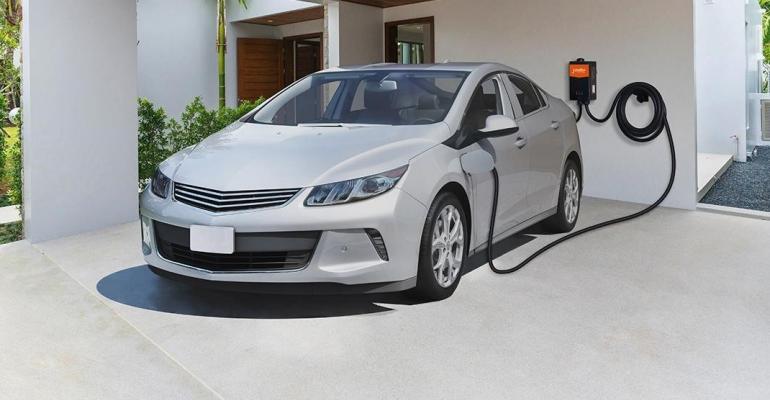In recent years, increasingly aggressive carbon-neutral energy goals (and in many cases, requirements) have been introduced globally. More than 100 nations, cities and states have made pledges to pursue a carbon-neutral future – some by 2050 at the latest, others even sooner.
Plans to meet these goals focus on two principal solutions: the decarbonization of electricity generation and decarbonization of transportation. This dual decarbonization effort is creating momentum for clean energy solutions as well as support for more electric vehicles.
While over 1.2 million EVs currently are on the road in the U.S., analysts predict adoption will speed up as EV costs continue falling as automakers partially or fully electrify their fleets. EVs offer consumers attractive cost savings such as lower electric charging costs versus gasoline, lower maintenance costs and federal, state and local rebates.
This growth will translate to millions of electric vehicles in our near future, charging at home or through a commercial charger. Quite the contrast from seeing long lines waiting at the gas pump.
Simultaneously, renewable energy is growing fast in the U.S., increasing 67% from 2000 to 2016, according to the Center for Climate and Energy Solutions.
In particular, solar continues to rise and is projected to make up over one-third of U.S. renewable generation by 2050. And the International Energy Agency predicts renewables will continue expanding in the next five years, covering 40% of global energy consumption growth from 2018 to 2023.
The new energy battleground will be the effective management of a complex, clean energy mix where there may be a surplus of renewable energy on the grid from daytime solar, making it less expensive and ideal for EV owners to plug-in and charge.
A priority question for the auto industry and clean energy industries to address as partners is beginning to emerge: how to ensure that millions of plugged-in EVs are adequately charged, while simultaneously maximizing the energy resources available on the grid at a given time?
Electric vehicles are effectively distributed batteries on wheels that can be turned into grid assets, as they often are plugged into a charging station far longer than the time needed for a charge. Through smart grid charging, IoT platforms can pause or delay charging to when electricity is cheapest and greenest – such as charging when the sun is shining to absorb excess solar energy on the grid. Using the EV fleet as a distributed energy resource will be a key step in making the zero-carbon future a reality.
Today, most smart EV charging involves a one-way flow of electricity and entails modifying the timing or rate of EV charging in response to an economic, environmental or operational signal. In the future, the electricity flows could go both ways from vehicle to grid, when energy markets catch up to technology and adequately value this grid service, known as vehicle-to-grid or V2G.
Overall, the acceleration of smart EV charging will increase environmental, economic and societal benefits while decreasing costs for all electric users. Specifically, a report from Synapse Energy indicates that, “from 2012 through 2017, EVs in California have increased utility revenues more than they have increased utility costs, leading to downward pressure on electric rates for EV-owners and non-EV owners alike.” This is in part because EV customers tend to charge during off-peak hours, imposing minimal costs to the grid.
As EV market share increases, regulators will need to consider how market structures and coordination procedures can maximize both driver and grid benefits from EVs, simultaneously reducing the need for expensive grid upgrades. If utilities and grid operators continue to incentivize charging during the day when there is excess power on the grid, everyone wins: Consumers benefit from more affordable electricity rates, while utilities benefit by selling power on the grid that otherwise would not be used.
 At Enel X e-Mobility, we currently manage over 40 Mw of “virtual battery” capacity contained in our JuiceNet-enabled EV chargers. A portion of this capacity is offered into the California ISO, the state’s wholesale energy market. By bidding these smart chargers into the electricity market, consumers, utilities and grid operators save money.
At Enel X e-Mobility, we currently manage over 40 Mw of “virtual battery” capacity contained in our JuiceNet-enabled EV chargers. A portion of this capacity is offered into the California ISO, the state’s wholesale energy market. By bidding these smart chargers into the electricity market, consumers, utilities and grid operators save money.
Automakers, in turn, also are in the early days of experimenting with vehicle-grid integration technologies, with several exploring programs (similar to Honda’s SmartCharge in partnership with Southern California Edison and eMotorWerks) that incentivize EV buyers and owners to charge when there is a high proportion of renewables available on the grid. Early-stage programs involve smartphone connectivity and push notifications with monthly monetary incentives. Future systems integrated directly into vehicles as a branded feature may make VGI use less of a barrier for electric-vehicle owners, adding value to a brand’s EV portfolio. As a bonus, these features align well with the personal value set of the contemporary EV buyer and serve as a valuable marketing tool for OEMs.
With vehicle-grid integration, automakers can simultaneously advance two high-level goals – the decarbonization of electricity generation and decarbonization of transportation – while deploying flexibility services that can facilitate renewables deployment. In this way, EVs have much more potential to impact our lives than gasoline-powered cars have today.
Preston Roper (above, left) is the head of e-Mobility for Enel X North America and was chief marketing & operating officer at eMotorWerks before the company was acquired.





